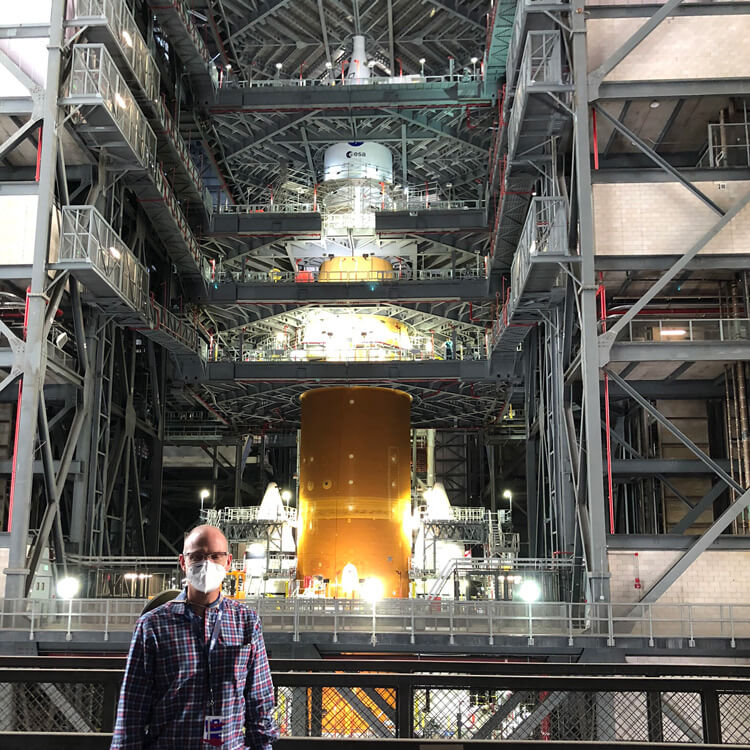How does a third grader struggling with dyslexia go on to become a PhD biologist and geneticist working on space missions with NASA?

In the case of Bruce Link ’81, it meant transferring schools to Colorado Academy, where class sizes were smaller, the student-to-teacher ratio was better, and the faculty truly cared.
“CA teachers paid attention to individual students,” says Link, who started at CA in Grade 4. “They took the time to get to know you and to really understand how you learned, which made their teaching better.”
With CA’s early support, Link went on to earn degrees from University of Rochester and Pennsylvania State University, to work as a biotechnologist for one of the world’s largest crop companies, and now, to contribute his knowledge as a subject-matter expert at the Kennedy Space Center.
All of which means, he’s following a long-held dream to work in space exploration—a dream that started when he was just a kid.
From CA to NASA
Link has vivid memories of watching Neil Armstrong and Buzz Aldrin walk on the Moon for the first time in 1969.
“Watching the launch of all the Apollo missions to the Moon on TV had a huge impact on me,” says Link, who now commutes from North Carolina to Cape Canaveral, Fla., to work for NASA. “I developed a fascination with space and with exploring new worlds.”
At about the same time that astronauts were pioneering space travel, biologists were pioneering the study of gene manipulation. Link remembers learning about the growing field of genetic engineering in his AP biology class at CA.
 He soon developed a second fascination, with biology and genetics. Pursuing these two passions academically, he has found his way to his dream job in space travel and exploration.
He soon developed a second fascination, with biology and genetics. Pursuing these two passions academically, he has found his way to his dream job in space travel and exploration.
“I’m working on providing food and water for astronauts on long-duration space missions, to the Moon and Mars,” he says. “That means growing crops in space.”
Concepts from his doctoral thesis were part of the 1998 “John Glenn Returns to Space Mission.” The astronaut team performed Link’s plant growth experiment while orbiting Earth and returned frozen samples for analysis.
“Because Glenn was the first American to orbit the Earth and a former United States senator, the President and most of Congress showed up for the launch,” Link says. “It was a huge event at the time and quite an experience for me.”
Newsflash: Chili peppers can grow in outer space

Link’s work doesn’t always involve world-famous people and historic missions, but it’s always pretty interesting.
“Where I like to work is on the cutting edge of technology, the edge between the well understood rules of engineering and all the areas of science that we’re trying to figure out,” he says.
Currently, the cutting edge he’s focused on is something called In-situ Resource Utilization (ISRU), which means “living off the land,”—wherever you happen to be…like a spaceship bound for Mars. It requires reusing materials as long as possible, as well as making materials to construct items you’ll eventually need months and years in the future.
As part of this work, the NASA team recently grew a batch of Hatch green chili peppers in the Advanced Plant Habitat (APH) as it orbited Earth. They’ve also grown kale, lettuce, radishes, mustard greens, microgreens, and other crops in space.
The APH is a very small, high-tech greenhouse, about the size of a “kitchen moving box” with fully automated mechanisms to control its temperature, humidity, light, carbon dioxide, and water levels. Currently, the APH contains a pseudo-soil to nourish the plants, but it is heavy, so the researchers are looking for a different solution.
Astronauts have enjoyed not only eating the vegetables but also simply looking at the green plants growing inside their space station. During long-duration space missions, which can last for years, live plants and fresh produce can help keep astronauts healthy, both physically and mentally.
Link and the teams he works with are fine-tuning their methods for increased reliability and sustainability, to ultimately feed astronauts as they live and work in space for years at a time.
Where you learn how to explore

Like many people who are fascinated with outer space, Link would love an answer to the big question: Are we alone?
Space researchers are continually searching for clues to whether other life forms exist in our universe. For instance, NASA studies of Jupiter’s moon, Europa, indicate that it has a large, liquid water ocean, a sign that life is possible there.
“My bet is that there’s life in that ocean,” Link says. “If I’m right, that will tell us that life is common in the universe. Then, we want to find out if the life form uses DNA to code itself and is that coding the same as on Earth?”
For Link, the questions and exploration never stop. That’s something he learned early in life, at CA.
“CA did a good job of teaching us to explore the world,” he says, remembering a CA hiking trip to the Grand Canyon. “We had opportunities for big outdoor adventures—the kinds of things that help a young person to venture out, experience beauty, overcome personal hardships, develop grit, and learn to have faith in their own abilities.”
And he met other future explorers at CA. To this day, his closest friends are fellow CA alumni.
So, will his exploration take him on a trip into outer space one day?
“At this point, it probably won’t happen,” he says. “But if I ever got the chance, I’d love to. I’d just have to check with my wife first!”
